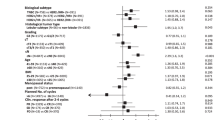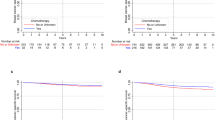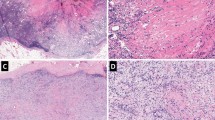Abstract
The heterogeneity of therapeutic modalities and eligibility criteria and the lack of long-term follow-up in most reports of neoadjuvant chemotherapy for breast cancer preclude us from drawing conclusions about its value in clinically relevant patient subgroups. The present study aims to identify predictive and prognostic factors in 107 non-inflammatory stage II/III breast cancer patients treated between November 1980 and October 1991 with an anthracycline-based induction regimen before locoregional surgery. Preoperative chemotherapy comprised 3-6 cycles of doxorubicin (pirarubicin after 1986), vindesine, cyclophosphamide and 5-fluorouracil. Type of subsequent surgery and adjuvant treatment were decided individually. In analysis of outcome, univariate comparisons of end points were made using the log-rank test, and significant (P < or = 0.05) pre- and post-therapeutic factors were incorporated in a Cox multivariate analysis. With a median follow-up of 81 months (range 32-164+ months), the median disease-free survival (DFS) is 90.5 months while median overall survival has not yet been reached. Cytoprognostic grade and histopathological response in both the primary and lymph nodes were independent covariates associated with locoregional relapse with or without DFS and overall survival. Eleven patients with pathological complete response remain free of disease with a 68-month median follow-up, while the 18 with residual microscopic disease on the specimen showed a 60% cumulative incidence of locoregional recurrence. Despite encouraging response rates based on clinical or radiological evaluation (87% or 70%), neither method showed any significant correlation with pathological response and failed to contribute prognostic information on patients' outcome. Pathological evaluation of antitumoral activity of primary chemotherapy remains a major source of prognostic information and might be used to select patients in need of additional adjuvant treatment.
This is a preview of subscription content, access via your institution
Access options
Subscribe to this journal
Receive 24 print issues and online access
$259.00 per year
only $10.79 per issue
Buy this article
- Purchase on Springer Link
- Instant access to full article PDF
Prices may be subject to local taxes which are calculated during checkout
Similar content being viewed by others
Author information
Authors and Affiliations
Rights and permissions
About this article
Cite this article
Brain, E., Garrino, C., Misset, JL. et al. Long-term prognostic and predictive factors in 107 stage II/III breast cancer patients treated with anthracycline-based neoadjuvant chemotherapy. Br J Cancer 75, 1360–1367 (1997). https://doi.org/10.1038/bjc.1997.230
Issue Date:
DOI: https://doi.org/10.1038/bjc.1997.230
This article is cited by
-
Sixteen years follow-up results of a randomized phase II trial of neoadjuvant fluorouracil, doxorubicin, and cyclophosphamide (FAC) compared with cyclophosphamide, methotrexate, and 5-fluorouracil (CMF) in stage III breast cancer: GOCS experience
Breast Cancer Research and Treatment (2014)
-
Prognostic Factors Affecting Locoregional Recurrence in Patients with Stage IIIB Noninflammatory Breast Cancer
World Journal of Surgery (2007)
-
Prognostic significance of pathological response after neoadjuvant chemotherapy or chemoradiation for locally advanced cervical carcinoma
International Seminars in Surgical Oncology (2006)
-
Therapieinduzierte Tumorregression beim Mammakarzinom
Der Pathologe (2004)
-
Clinical experience of weekly paclitaxel-based treatment as preoperative chemotherapy for patients with primary breast cancer
Breast Cancer (2004)



